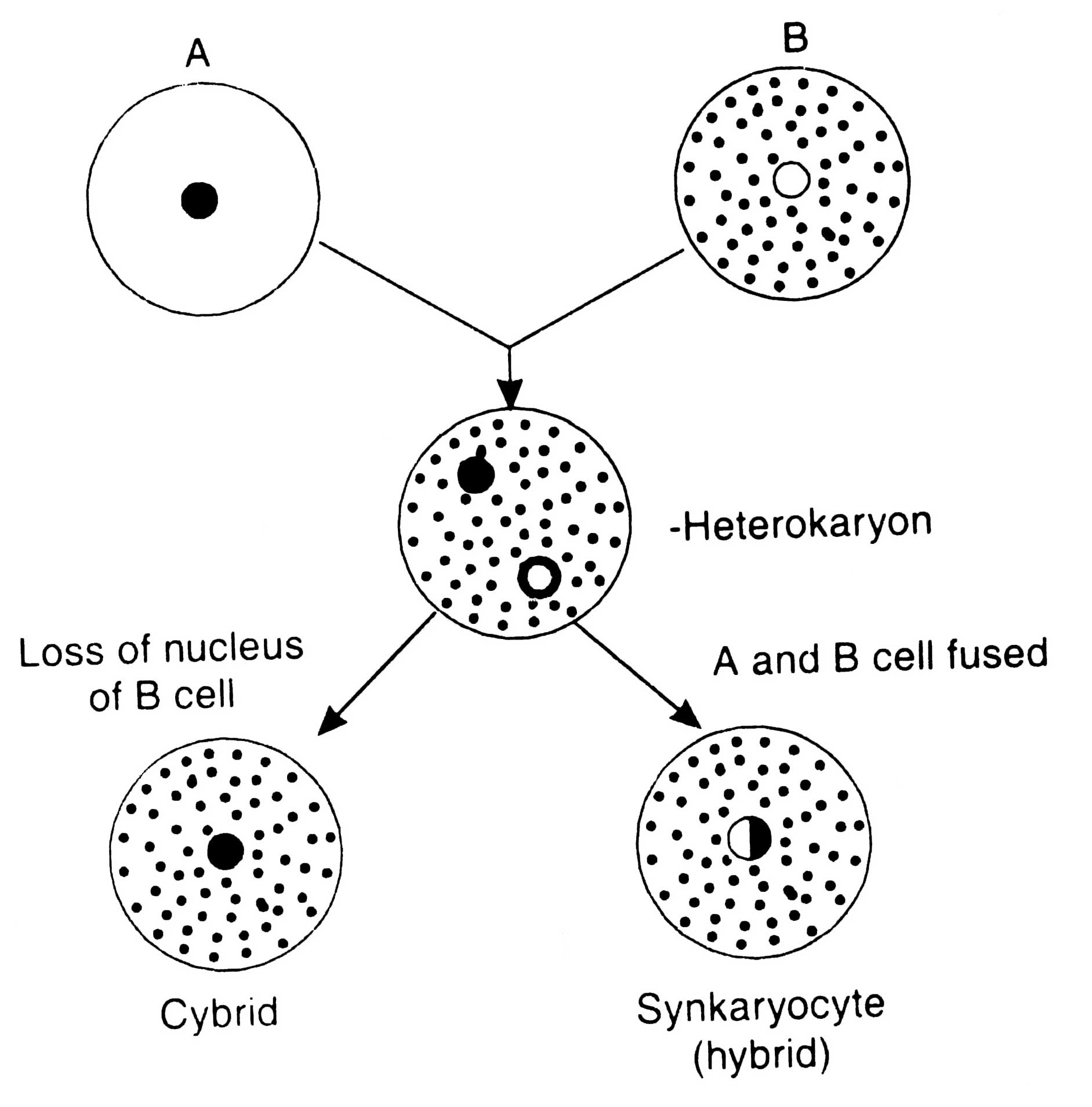Protoplast Fusion and Somatic Hybridization
The results obtained so far from somatic hybridization represent that it is possible to recover fertile and stable amphidiploid somatic hybrids after protoplast fusion. Schieder (1982) discussed four major aspects of protoplast fusion as (i) production of fertile amphidiploid somatic hybrids of sexually incompatible species is achieved. Induced fusion of protoplasts from two genetically different lines of species must results in a variety of homo-as well as heterokaryotic fusion products (heterokaryon or heterokaryocytes). Selection of a few true somatic hybrid colonies from the mixed population of regeneration protoplast is a key step in successful somatic hybridization technique; (ii) production of heterozygous lines within one plant species which normally will be propagated only vegetatively e.g. potato; (iii) the transfer of only a part of genetic information from one species to another using phenomenon of chromosome elimination, and (iv) the transfer of cytoplasmic genetic information from one to a second line or species.
It has been possible to transfer useful genes (e:g nif genes, disease resistance genes, rapid growth genes) from one species to another, thereby, to widen the genetic base for plant breeding.
Fusion products - the hybrids and cybrids
Fusion of cytoplasm of two protoplasts results in coalescence of cytoplasms. The nuclei of two protoplasts may or may not fuse together even after fusion of cytoplasms. The binucleate cells are known as heterokaryon or heterocyte (Fig. 8.7.) When nuclei are fused the cells are known as hybrid or synkaryocyte (Constabel, 1978), and when only cytoplasms fuse and genetic information from one of the two nuclei is lost is known as cybrid i.e. cytoplasmic hybrid or heteroplast (Doods and Roberts, 1985). There are some genetic factors which are carried in cytoplasmic inheritance, instead of nuclear genes, for example, male sterility in some plants. Susceptibility and resistance to some of the pathotoxins and drug are controlled by cytoplasmic genes. Therefore, production of cybrids which contain the mixture of cytoplasms but only one nuclear genome can help in transfer of cyloplasmic genetic information from one plant to another. Thus, informations of cybrid can be applicable in plant breeding experiments. (Vasil, 1982).
In China cybrid technology in rice is a great success. Such plants are very useful in producing hybrid seeds without emasulation, However, cybrid technology has successfully been applied to carrot, Brassica sp, Citrus, tobacco and sugar beet (Balasubramanian et al. 1996).
Methods of somatic hybridization
Procedure for successful somatic hybridization is as below: (i) isolation of protoplasts from suitable plants, (ii) mixing of protoplasts in centrifuge tube containing fugigenic chemicals i.e. chemicals promoting protoplast fusion, such as polyethylene glycol (PEG) (20%, W/V), sodium nitrate (NaNO3), maintenance of high pH 10.5 and temperature 37°C (as a result of fusion of protoplasts viable heterokaryons are produced. PEG induces fusion of plant protoplasts and animal cells and produces heterokaryon (Davey et al, 1978), (iii) wall regeneration by heterokaryotic cells, (iv) fusion of nuclei of heterokaryon to produce hybrid cells, (v) plating and production of colonies of hybrid cells, (vi) selection of hybrid, subculture and induction of organogenesis in the hybrid colonies, and (vii) transfer of mature plants from the regenerated callus.
Gamborg and Nabors (1987) have described a number of variations in cell fusion as firstly, fusion of two protoplasts each from cells with normal parental ploidy, secondly, fusion of two protoplasts each obtained from haploid cell sources (the fusion of two diploid cells of Solarium sp. would yield a tetraploid which is the normal ploidy for potato, and thirdly, fusion of a protoplast with an enucleated protoplast. The result of this type of fusion would bring about cybrid with a single nucleus of one parent and the respective ploidy.
Carlson (1972) succeeded in carrying out protoplast fusion of Nicotiana glauca x N. langsdorffii. Simlarly, Kuchko (1985) achieved somatic hybrid through inter-specific cross of wild and cultivated variety of potatoes i.e. Solarium tuberosum x S. chacoense.
Intergeneric hybrids which may be difficult to achieve by sexual crosses have been obtained through protoplast fusion e.g. tomato + potato, Datura + Atropa, barley+wheat, barley+ rice, wheat+ oat, and sugarcane + sorghum. Potato+tomato cross is shown in text ( Fig. 8.7.). With regard to inter familial cell hybrids, there have been very few successful experiments to obtain such hybrids, for example, hybrids of Glycine sp + Nicotiana species, (Kao, 1977; Chien et at, 1982). Based on detailed studies on inter familial hybrids, it has been concluded that inter familial hybrids of plant cells are genetically unstable and show species specific elimination/ reconstruction of chromosome belonging to one of the parents; this was usually the parent represented by the mesophyll cells in hybridization process. These hybrids are incapable of regeneration and morphogenesis into plants (Gleba, 1985). Similarly, intertribal hybrids were studied more widely due to their higher genetic stability; the first intertribal cell hybrid was obtained by Gleba and Hoffmann (1978) from callus cells of Arabidopsis thaliana crossed with mesophyll protoplasts of turnip (Brassica compestris).








